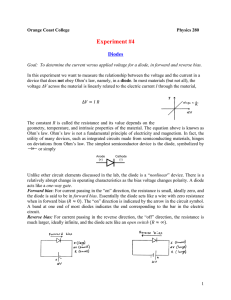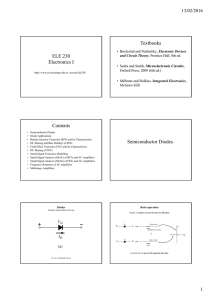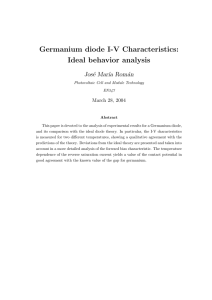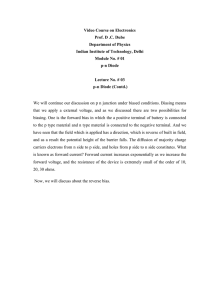Observation of diode characteristics
advertisement
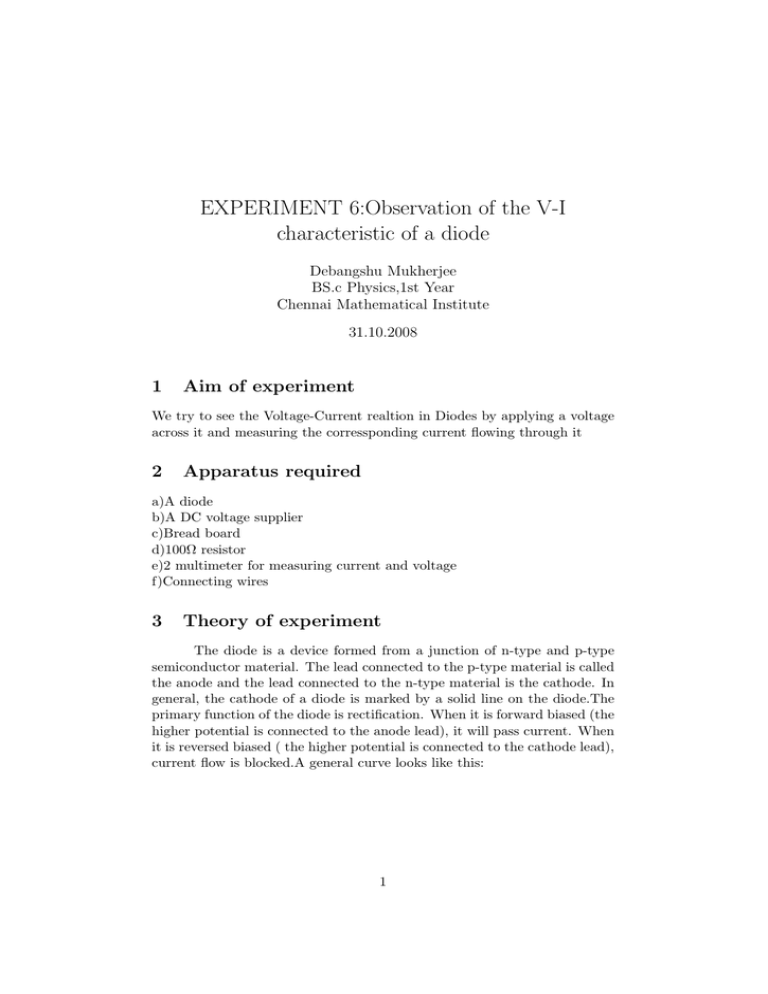
EXPERIMENT 6:Observation of the V-I characteristic of a diode Debangshu Mukherjee BS.c Physics,1st Year Chennai Mathematical Institute 31.10.2008 1 Aim of experiment We try to see the Voltage-Current realtion in Diodes by applying a voltage across it and measuring the corressponding current flowing through it 2 Apparatus required a)A diode b)A DC voltage supplier c)Bread board d)100Ω resistor e)2 multimeter for measuring current and voltage f)Connecting wires 3 Theory of experiment The diode is a device formed from a junction of n-type and p-type semiconductor material. The lead connected to the p-type material is called the anode and the lead connected to the n-type material is the cathode. In general, the cathode of a diode is marked by a solid line on the diode.The primary function of the diode is rectification. When it is forward biased (the higher potential is connected to the anode lead), it will pass current. When it is reversed biased ( the higher potential is connected to the cathode lead), current flow is blocked.A general curve looks like this: 1 In the forward-bias region the V-I relationship is described as follows: V I = Is (e nVT − 1) In the above equation, I is the forward current, V is the forward voltage, It is the saturation current, and VT = kT /q is the thermal voltage. Initially, the V vs I graph is linear but then after reaching breakdown, it becomes exponential. 4 Procedure First, complete a circuit as shown below with a 100Ω resistor and an variable DC input voltage source. We first note the point where the ammeter starts deflecting. We note this point and gradually increase the input voltage and take the corressponding current readings. We have to take many readings till the input voltage is 2 about 30V. On plotting an V vs I curve, we will get a clear picture of the diode characteristic. Now, we change the direction of voltage that is being applied. Then, we can get the readings in reverse bias. These readings on plotting will be linear. 5 Claculations 5.1 S.No 1 2 3 4 5 6 7 8 9 10 11 12 13 14 15 16 17 18 19 20 21 22 23 24 25 26 27 28 29 30 31 32 33 34 Readings for forward bias Voltage(V ) 0.283 0.347 0.370 0.395 0.425 0.435 0.445 0.467 0.485 0.496 0.503 0.517 0.525 0.527 0.538 0.544 0.555 0.563 0.573 0.575 0.585 0.592 0.598 0.605 0.618 0.623 0.630 0.646 0.653 0.658 0.665 0.672 0.677 0.680 Current(mA) 0 0.001 0.001 0.005 0.009 0.012 0.018 0.047 0.060 0.082 0.101 0.145 0.175 0.181 0.246 0.306 0.412 0.509 0.646 0.693 0.822 0.979 1.112 1.335 1.805 2.007 2.392 3.4 3.9 4.3 5.3 6.7 7.6 8.0 3 5.2 Measurement in reverse bias S.No 1 2 3 4 5 6 7 8 9 10 11 12 13 14 15 16 17 18 19 20 6 Voltage(V ) 0.90 1.60 2.07 3.78 4.94 5.95 7.27 8.01 9.32 9.84 10.34 11.94 12.77 13.93 15.11 16.32 17.03 17.81 18.56 19.35 Current(µA) 0 0.001 0.002 0.003 0.004 0.005 0.006 0.007 0.008 0.009 0.010 0.011 0.012 0.013 0.014 0.015 0.016 0.017 0.018 0.019 Results We plot the readings on a V vs I curve and the two graphs look as follows: Forward bias graph: 4 Reverse bias graph 7 Discussion •If, we just reverse the diode to measure the I-V characteristics, the sudden change might destroy the diode. •The diode should not be short-circuited. That will allow a flow of huge current which might destroy the diode. •Current must not pass through it for a very long time. It will then increase the depletion region and develop a fluctuating resistance. 5




